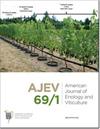终点PCR、qPCR、LAMP和视觉症状诊断葡萄红斑疹病的比较
IF 1.8
3区 农林科学
Q3 BIOTECHNOLOGY & APPLIED MICROBIOLOGY
引用次数: 3
摘要
摘要背景与目的葡萄红斑病(GRBD)是由葡萄红斑病毒(GRBV)引起的一种疾病。由于葡萄藤症状的性质和检测方法的复杂性,GRBD的诊断往往具有挑战性。在2020年和2021年,我们使用从俄勒冈州南部的一个商业葡萄园收集的样本,比较了四种GRBV检测方法的准确性。方法和关键发现采集了20株grbv阳性和阴性葡萄的基部、中部和顶端茎节在坐果、变型、收获和休眠阶段的组织样本。在采集葡萄时记录GRBV症状,并使用环介导等温扩增(LAMP)、终点PCR和定量PCR (qPCR)对叶片样本进行GRBV检测。grbv阳性藤蔓的检测能力在不同的节点位置存在显著差异,这取决于物候。在坐果和变异时,qPCR和终点PCR检测的灵敏度为98%,而LAMP检测的灵敏度分别为49%和78%。在收获和休眠时,所有检测方法在基础和中间样本中的灵敏度均为100%,LAMP、终点PCR和qPCR之间无显著差异。grbv阳性的葡萄样品在坐果时没有表现出症状,而31%的基冠样品在坐果时表现出症状。在收获时,90%的葡萄树表现出症状,与其他方法没有显著差异。同样,在坐果时,LAMP的特异性小于75%,而在变型和收获时,所有基于dna的检测方法的特异性都增加到100%。结论和意义本研究结果表明,如果需要早期诊断,基于pcr的检测是最准确的选择;较便宜的方法,如LAMP和基底冠层症状,在物候后期是可靠的。这些发现有助于更好地理解GRBV检测,并使其他研究人员、酿酒葡萄和苗圃行业受益。本文章由计算机程序翻译,如有差异,请以英文原文为准。
Comparative Diagnosis of Grapevine Red Blotch Disease by Endpoint PCR, qPCR, LAMP, and Visual Symptoms
Abstract
Background and goals
Grapevine red blotch disease (GRBD) is caused by grapevine red blotch virus (GRBV). GRBD diagnosis is often challenging because of the nature of symptoms in grapevines and complexity of testing methods. In 2020 and 2021, we compared the accuracy of four GRBV detection methods using samples collected from a commercial vineyard in southern Oregon.Methods and key findings
Tissue samples were collected at fruit set, veraison, harvest, and dormancy from basal, middle, and apical shoot nodes of 20 GRBV-positive and negative vines. GRBD symptoms on grapevines were recorded at the time of collection, and leaf samples were tested for GRBV using loop-mediated isothermal amplification (LAMP), endpoint PCR, and quantitative PCR (qPCR). The detectability of GRBV-positive vines by the assays differed significantly among node positions, depending on phenology. At fruit set and veraison, the sensitivity of qPCR and endpoint PCR assays was 98%, whereas the sensitivity of LAMP was 49% and 78%, respectively, from basal leaf samples. At harvest and dormancy, the sensitivity of all assays was 100% in basal and middle samples, and no significant differences were detectable between LAMP, endpoint PCR, and qPCR. None of the GRBV-positive grapevine samples expressed symptoms at fruit set, and 31% of the basal canopy samples expressed symptoms at veraison. At harvest, 90% of these vines expressed symptoms, which was not significantly different than other methods. Similarly, at fruit set, the specificity of LAMP was less than 75%, whereas at veraison and harvest, it increased to 100% for all DNA-based detection methods.Conclusions and significance
The results of this study show that PCR-based assays are the most accurate option if early diagnosis is needed; less expensive methods such as LAMP and basal canopy symptoms are reliable at later phenological stages. These findings contribute to the better understanding of GRBV detection and benefit other researchers, winegrape, and nursery industries.求助全文
通过发布文献求助,成功后即可免费获取论文全文。
去求助
来源期刊

American Journal of Enology and Viticulture
农林科学-生物工程与应用微生物
CiteScore
3.80
自引率
10.50%
发文量
27
审稿时长
12-24 weeks
期刊介绍:
The American Journal of Enology and Viticulture (AJEV), published quarterly, is an official journal of the American Society for Enology and Viticulture (ASEV) and is the premier journal in the English language dedicated to scientific research on winemaking and grapegrowing. AJEV publishes full-length research papers, literature reviews, research notes, and technical briefs on various aspects of enology and viticulture, including wine chemistry, sensory science, process engineering, wine quality assessments, microbiology, methods development, plant pathogenesis, diseases and pests of grape, rootstock and clonal evaluation, effect of field practices, and grape genetics and breeding. All papers are peer reviewed, and authorship of papers is not limited to members of ASEV. The science editor, along with the viticulture, enology, and associate editors, are drawn from academic and research institutions worldwide and guide the content of the Journal.
 求助内容:
求助内容: 应助结果提醒方式:
应助结果提醒方式:


